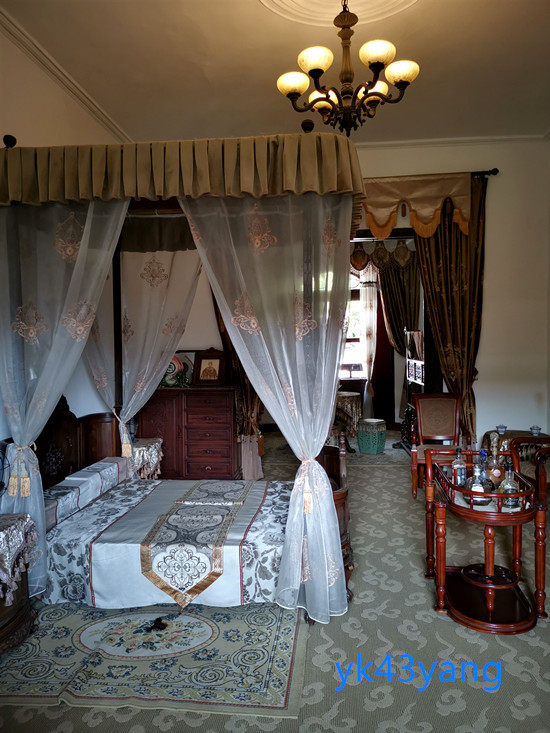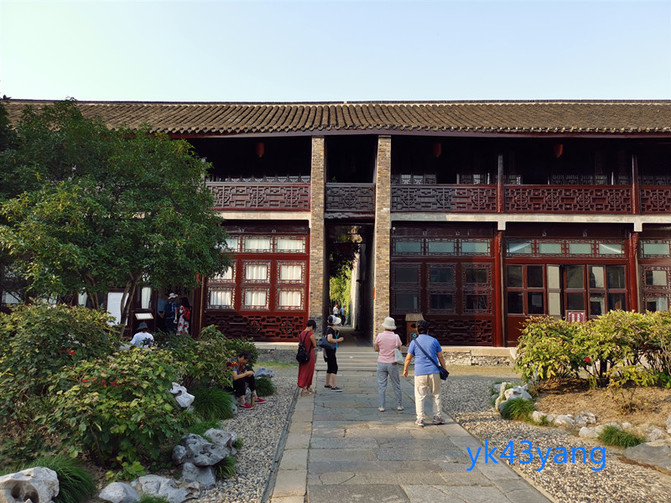Yangzhou Travel Notes (2)--He Yuan (middle)
Shuixin Pavilion is the opera pavilion of He Yuan. There is a platform in front of the pavilion, where the troupe performs. It can be viewed in both the Butterfly Hall and the two-story corridor. Silk and bamboo music comes from the water, which is wonderful!


Around the pool around the West Garden, there are also rockery made of Taihu Lake stones. Mountains and rivers intersect each other like pictures.

From the second floor of the Fudao Corridor, you can directly walk to the second floor of the Jade Embroidery Tower.


Jade Embroidery Tower is the garden courtyard of He Yuan. The Jade Embroidery Tower consists of two two-story buildings in the north and south, connected by a two-story corridor to form a courtyard in the shape of a circle. The courtyard in the middle is planted with magnolia and hydrangea trees. This is where the name of jade embroidery comes from.
This magnolia tree is tall and straight, with green leaves. It is also one of the treasures in the garden. This tree came from North America and was distributed by the Empress Dowager Cixi to meritorious personnel in the Huai Army. He Zhi was fortunate enough to have two plants planted here, which has a history of 145 years. In the 1950s, some people thought that the crown of Magnolia was too big and blocked out the sunshine upstairs, so they cut off the east. The existing tree has become a target for tourists to watch and take photos.

The hydrangea tree in the center of the courtyard is also 145 years old. Like Magnolia, it is an ancient and famous tree in Yangzhou City. Hydrangea trees are a symbol of love, as well as hope in life and harmony in family.
Jade Embroidery Tower is where the owner's family lives. The north building is He Zhiyan's room, while the south building is for his children. There are still some rooms displaying scenes from that time. As for whether it is the original thing, it is unknown.




I went downstairs to the courtyard and took some photos. Then through the cave door, we arrived at the courtyard in front of the Yueyuan Tower.

Shangyue Building, also known as Yixuan Building, is a small building with three rooms and two floors. Because this is the best place to admire the moon, it is called the "Moon Appreciation Tower". Fengyue Building is where He Zhiyan's mother lives.
The first floor of the Yueyuan Building is also called the Tongren Hall. The word "Tongren" refers to a school once founded in Heyuan-Tongren Middle School. Tongren Hall was once a classroom in Tongren Middle School.
The courtyard floor is paved with pebbles with patterns such as blessing, longevity and phoenix and osmanthus offering, reflecting the owner's interest and pursuit. The rockery in front of the court is exquisite and elegant, which is an extension of the rockery in the West Garden.

The ancient privet tree in the courtyard is more than a hundred years old. Legend has it that He Zhizhen planted it for his mother and is a "filial piety tree".

This is the rockery in front of the Yueyanglou:

From the courtyard of the Yueyuan Tower, we passed through the cave door and returned to the West Garden. Just now we looked down on the second floor overlooking the West Garden, and now we are visiting it again on the ground.
Arriving at Shuixin Pavilion, there is a curved bridge to walk onto the pavilion. The decoration of the Shuixin Pavilion is extremely exquisite. No wonder it can claim to be "the best in the world"!

Watch the Butterfly Hall opposite from the water.

Arrived at the lower level of the Fudao Corridor. There are many flowered windows of different shapes open on the corridor wall. Looking out from each flower window, you can see different scenery of the garden, just like pictures.
The flowered windows of the corridor are also unique to He Garden, known as the "first window in the world".




From these flowered windows, you can see the north building of Yuxiu Building next door. There is also a mysterious century. Each flower window corresponds to every window on the jade embroidery building. Miss can sit upstairs and listen to the music coming from the Shuixin Pavilion during the performance through the flowerbed window.
Arrived at Xuchun Hall south of the south building of Yuxiu Building.



Xuchun Hall is the hall where the owner receives distinguished guests. It uses precious nanmu buildings, so it is commonly known as the "nanmu Hall". This is the largest and most completely preserved nanmu hall in Yangzhou.
Wuxi Meiyuan also has a nanmu hall, but only the main beams of the hall are made of nanmu. But this one is the entire hall made of nanmu. It can be seen that the He family has strong financial resources!
Xuchun Hall has a five-room width, resting on the top of the mountain, and a corridor is set up in front of the hall. There is a couplet hanging on the middle porch column: "Retired soldiers eat quinoa and amaranth all their lives, and scattered people thousands of miles in the Jianghu." This was written by He Shaoji, a poet and calligrapher in the late Qing Dynasty.
The huge window glass used in the hall is 9 mm thick and is said to be imported from France and is very valuable. A plaque "Xuchun Hall" hangs in the center of the hall, and the couplets on both sides: "Don't let the Spring and Autumn Festival pass by; the most difficult weather comes when old people come" were written by Sun Xingyan, a native of the Qing Dynasty.
Nanmu Hall turns east and then south to reach the south exit. We headed north from the south gate and arrived at this riding building.

The Riding Building is a symmetrical building in a combination of Chinese and Western styles. It is divided into the east and west floors with the middle roadway, shaped like a saddle, so it is called the Riding Building.
Entering from the middle alley, there are two buildings behind them, the second and third floors. The three buildings are connected from front to back and left, which is quite spectacular.
The Riding Building is the guest house of the He family, used to entertain guests. Huang Binhong, a famous master of traditional Chinese painting, has been to Yangzhou six times and lives on the first floor of the East Riding Building. The famous writer Mr. Zhu Qianhua once lived on the second floor of Heyuan East for more than five years.
On the east side in front of the Riding Building is the fourth part of He Garden-Pianshishan House.
